Territory, body, earth.
These are concepts used by the Maya-Xinca activist Lorena Cabnal, whose activism has inspired people outside the Abya Yala to advance feminism that is communitarian and differs from the more traditional “white” feminism. Her concept of “acuerpamiento” underlined the workshop and installation “Corpas que Voam” held in São Paulo in September 2023, created and led by the visual artist and psychologist Rosamaria Bolom.
Lorena Cabnal’s definition of territory does not refer to a territory just on a map, but for the Maya, a territory incorporates the languages, cycles of the moon, weavings, medicine, calendars, forms of organising, planetary relations and more.
Hence, the notion of body-territory implies there is another level of conscience of the body’s relation with the territory, that comes with all the mentioned. As for other feminists, for the communitarian feminists, the personal is political, and one has the right to choose over one’s body. However, at the same time, the body is not separate from the territory and all the things that come with it. The personal must come also with the relationship we have with our territory.
For Cabnal, a plurality of thought as well as feeling-thinking (sentipensar – abbreviation from the Spanish sentir–pensar) is key. The latter refers to not prioritising the “mind” over emotions and feelings, the things we often term as “irrational”, and dismiss the cues they give us.
Our bodies may be subject to multiple oppressions, at different moments. Our bodies may need healing. The first territory to defend is your body. We need to meet up in person and have those face-to-face interactions. To share knowledge, and to “feel-think” together. The process involves unlearning and learning and denouncing colonial and patriarchal attacks on the earth that happen with the plundering of resources.

The workshop Corpas que Voam in São Paulo, led by Rosamaria Bolom, was one of those spaces where acuerpamiento was put into practice. Rosamaria has a history of conducting workshops combining art, conversation and activism in Finland, where she has for years made her home.
It was also feeling-thinking that led Rosamaria to move to Finland.
She had planned to move with her Finnish partner to Argentina, where she was going to continue her career in psychology, but after losing all digital files and important travel papers while going to the airport, something inside her was telling her Argentina was not her destiny.
Before leaving Mexico, she had already sensed the structures of the scientific methods as symbolically violent working as a psychological evaluator of people applying for different job positions. Having to evaluate candidates looking for a job, and make decisions about who to hire, caused contradiction. Her feeling-thinking instructed her to dedicate more time to art.
Rosamaria’s incursion into the world of art was marked by her formative experience with the Zapatistas[1], with whom she worked in an educational volunteer program with like-minded socially engaged youth. She even got her artist name “Bolom” from that period. Bolom was a word is a tzotzil word for “jaguar”. Whenever she passed by, the children of the community would shout out “bolom, bolom”, referring to her feline-shaped eyes.
Rosamaria found that the life of the community was hard, but what she learned from that period has stayed with her ever since. When she came back, she decided to dedicate herself more to art, and she began to approach questions relating to social tensions.
In Finland, Rosamaria has worked with masks and paper dolls, among other things. Some of the themes she works with revolve around questions of religion, capitalism, human rights and particularly the rights of children. She has worked on these themes through workshops and installations that have travelled through Finland.

Rosamaria does not shy away from making her art political. The increased xenophobia as inequality intensifies is felt in all European countries, and Finland is no exception. It has made her more dedicated to working with the migrant feminist community in Finland so that no one would speak for them.
When conducting her workshops with migrants in Finland, she began to see that the label “feminist” was necessary, even if it meant some people did not want to attend the workshops anymore. It allowed for position-taking. She joined with other Latin American artists and researchers to form the collective “Somos La Colectiva”.
Rosamaria, together with her fellow feminist colleagues, saw something was missing in the feminist discussion in Finland. She found she was surrounded by an academic “white feminism”, that was not always relatable to the women she was working with. She also got inspiration from the feminism surging in Latin America, which had different kinds of claims to feminism in Northern countries.
That is when feminismos otroas comes in. It is a definition used by Rosamaria in her workshops through Red de Mujeres in Helsinki, to open a space to “other” kinds of feminism from the established mainstream feminism.
Aside from the performative and visual aspect that is characteristic of Latin American feminist movements (e.g. Las Tesis’s performance “A rapist in your path”, and NiUnaMenos movement), a thing that sets it apart from Norther feminism is the concept of care, for body and territory, as defined by Cabnal’s communitarian feminism.
While Latin American feminism takes a stand against the traditional patriarchal roles assigned to genders, where women are socialised to conduct free labour at home, it also recognises the relationality of beings, and the value of care as essential to care for the Earth and its beings[1]. This implies a relational aspect of living. We do not stand above nature and other people, but we live in a complex web of interdependence that does not automatically cease to exist the moment we die.
Introducing to Finland some more nuanced Mexican views about death and dying through art, Rosamaria has worked on creating skeletons using the Mexican cartoneria technique. She recounts how in Mexico in some communities, when someone dies, everyone collaborates in making the food, one family can bring the chicken, and another can bring the pig. The tradition holds that if you die, and there is no food, it could mean your soul doesn’t have a good end.
Indeed, women having distinctive, even spiritual powers inside the home is an aspect often undermined in the Western narrative of feminism. Spirituality does not belong to our vocabulary, except in the realm of the “irrational”.
Communitarian feminism instead acknowledges that caring for the dead grants power to the one doing the caring, which in most cases are the people identifying themselves as women. In “Dialogues with the Dead”, anthropologist Piers Vitebsky worked among the Sora of India and writes about the power women have as shamans conducting dialogues with the dead.
The Sora perceive that a person does not die away immediately after death, but becomes a sonum, a type of ghost in our understanding, who lives in the underworld and can inflict pain and illness on the living. Dialogues are held regularly with the sonums to understand events among the living, why a certain person has fallen ill, and what the sonum is after.

For Vitebsky, the dead, the sonum, express memory. Dialogues are moments of healing, where the living are healed through taming the dead. The sonums will at some point have a funeral in the underworld, and later they will be rumoured to have become butterflies. This expresses the people’s memory of the living person.
The way Sora view death and the afterlife is reminiscent of the way Rosamaria describes processes around the death of a person in Mexican society. A dead person does not go directly to the afterworld, but she/he may have something unfinished in the present. Therefore, she/he must be appeased by food gathered by the women of the community.
This kind of understanding expands the scope by which we may be able to see our relationships with others. By caring for others, – even the dead -, we are ultimately caring for ourselves, and the aspects of our personality that get affected by the relations we have, and the sudden shifts that occur in our personality consequently when a person dies.
Care is, therefore, a fundamental aspect of life, and not solely “free, undervalued labour performed by women” as often is repeated even in the feminist narrative of the North. The Northern narrative has placed the model of the welfare state as the prime redistributor of care, which often tends to extract people’s relationships from each other, and relegates the elderly and disabled to be cared for solely by professionals in institutions.
In politics, the discussion seems to only revolve around how to gain more foreign hands to do the work of caring, and how to reconcile the demand for care labourers with xenophobic migration policies.
A more transformative approach to the care crisis requires people to do the actual work of practice[3]. To meet up with each other and have those discussions about sharing duties and doing something for one another. It involves instructing our children to spend at least a few months doing care work, and even the most highly achieved academic spending some time caring.
Importantly, a relational approach to care would mean that care would also become valorised in national economies. With the boom in start-ups, technological innovations could focus on products that make care work easier (robots that lift and wash, why not!), allowing care workers to spend more time in more meaningful activities when caring, like going out and having long conversations, all processes that can also be a form of acuerpamiento.
***
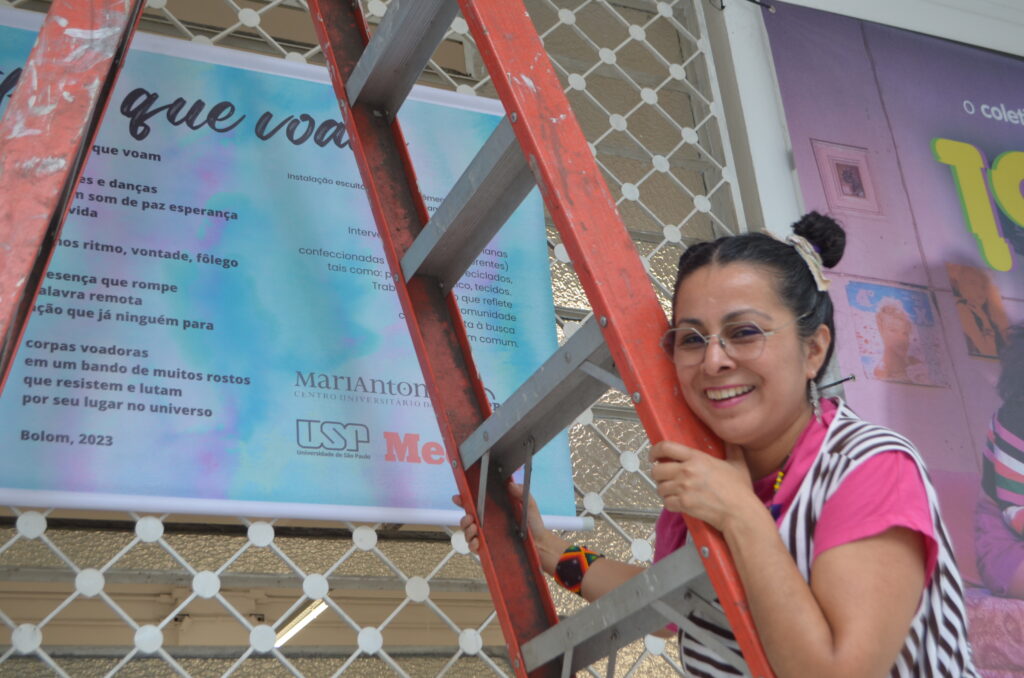
Above all, to put care centre stage means recognising and embracing our interdependencies. Our chains of supply are interconnected and interdependent, yet the benefits are hugely unequally distributed. We are dependent on Earth for its resources, and the plundering and unequal exploitation of Earth’s resources has resulted in a system that increasingly pushes people to migrate more.
Cabnal calls for migrant women to unite themselves through acuerpamiento. Migration brings with it the oppressions that come with the sense of detachment. But as Cabnal reminds us, our bodies exercise power, but not Nature. There are ways we can feel connected again and enjoy Nature, wherever we are.


In her workshop, Corpas que Voam Rosamaria took the concept of “acuerpamiento” to create carton dolls where we could place our thoughts and feelings about our bodies in the world. We discussed our childhood memories and practised visualising the conversations we had about experiences of Covid19 crisis, the way we felt when young, our experiences of migration, the way we feel now and what we wished for the future.
The hands-on work of creating the “cuerpa” out of recycled carton, textile and wire cleared out the thoughts of the day. “Mexicanness” travelled in the method of cartoneria. For Rosamaria, working with recycled material is important to highlight the varied uses that different materials can have. The installation allowed the individual process to become a collective piece, provoking people who passed by.
Rosamaria explains the reasons she chose to work with “flying bodies” in the workshop.
Creating the dolls was cathartic.
Each doll could have a small “placard”, a textile written with a slogan. My doll had a placard stating Dina Asesina, a slogan that circulates the social media in Peru after the brutal attack on young protestors by the interim government of Dina Boluarte that saw a death toll of between 60 to 70 people, with deeply rooted racism legitimating state’s use of force. Most of the deceased were young boys between 15 to 25 years of age, coming from peasant families in the Southern Andes.
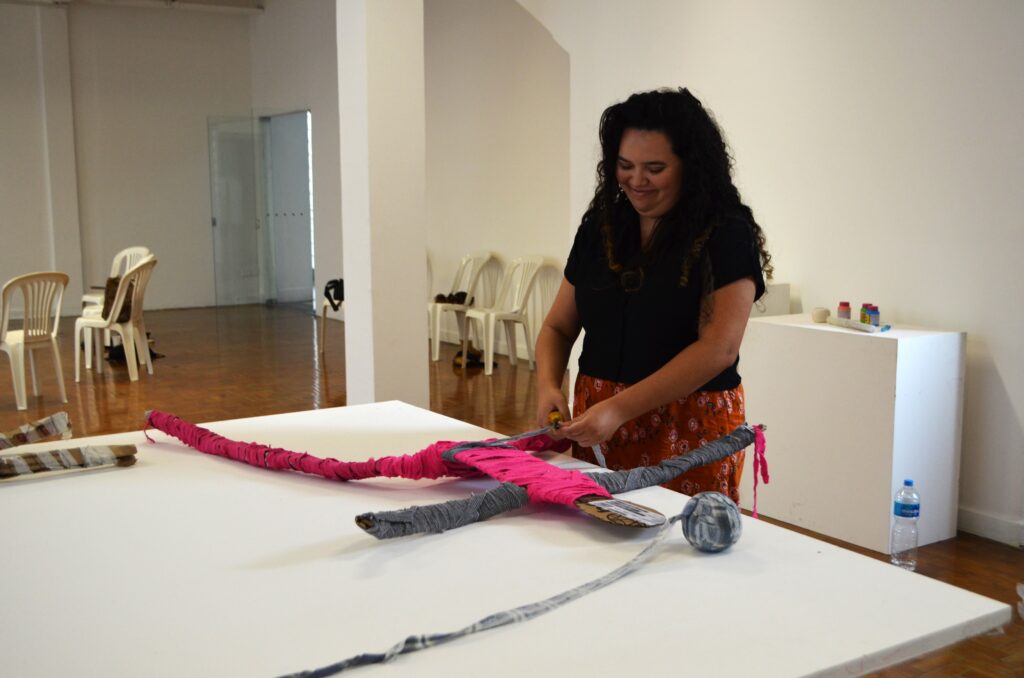


The cuerpa created by Fernanda Sotto, a Bolivian and Quechua artist and activist from the collective Cholitas de Babilonia carried a banner stating no al marco temporal.
At the time of the workshop, legislation upholding a so-called “time-marker” theory (marco temporal) was debated in Brazil. According to it, indigenous peoples can only lay claim to land they physically occupied as of October 1988, when the current constitution was promulgated. The time-marker theory was voted in September as unconstitutional by the Brazilian Supreme Court, yet less than a week later, the Senate voted to enshrine the theory into law.
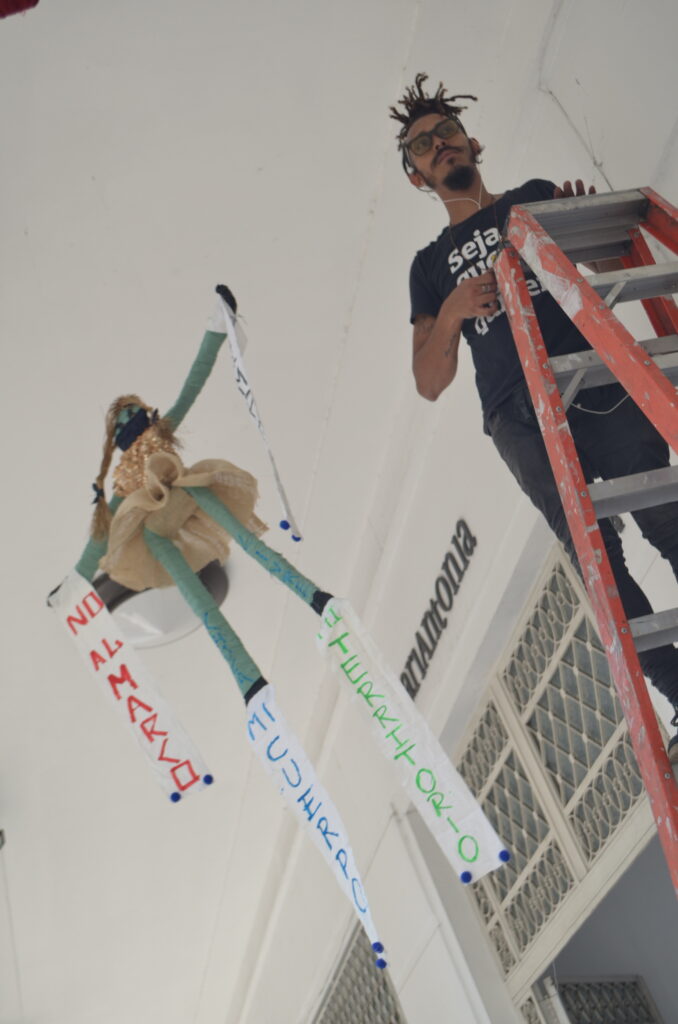
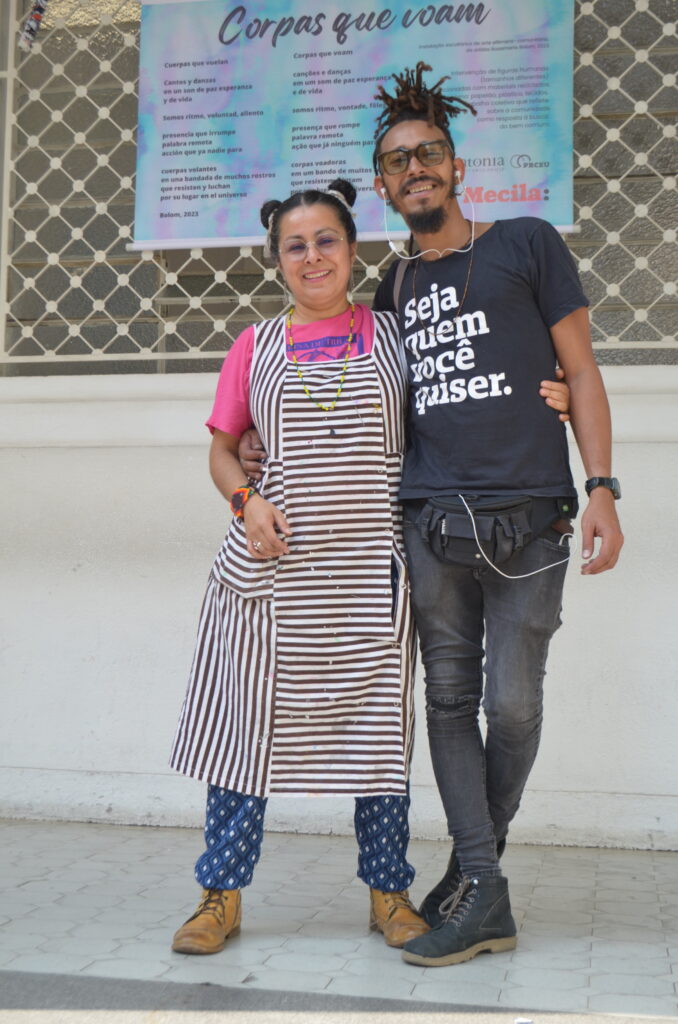
We continued the process of acuerpamiento in a Sarau held at Café Colombiano, where the visual artist Angel Alfaro took us to recite poems and see other people’s performances. Fernanda explained the meaning behind the colours of the Whiphala symbol, and other people discussed concerns of migrants.
Attesting that the world is small, a Brazilian woman who had lived years in Finland, – but returned to Brazil because she could not withstand the cold weather of Finland -, performed las Tesis’s collective’s “El violador en tu camino”. The same performance was conducted in Helsinki in the Women’s Day march in 2020, where Red de Mujeres and Solidaridad con Chile took an organising role.
It was a perfect reminder that rebellious art travels, gets reproduced and at best impacts our thoughts and relationships with others, and thereby our personality. Therefore, art has the potential to transform societies when cultivated by people, organisations, institutions and communities that get together in a sarau to exchange thoughts and practices.
The feminisms of Abya Yala that place care of the body and territory at the centre are alive and resist, and at best, have the potential to transform our relationships.


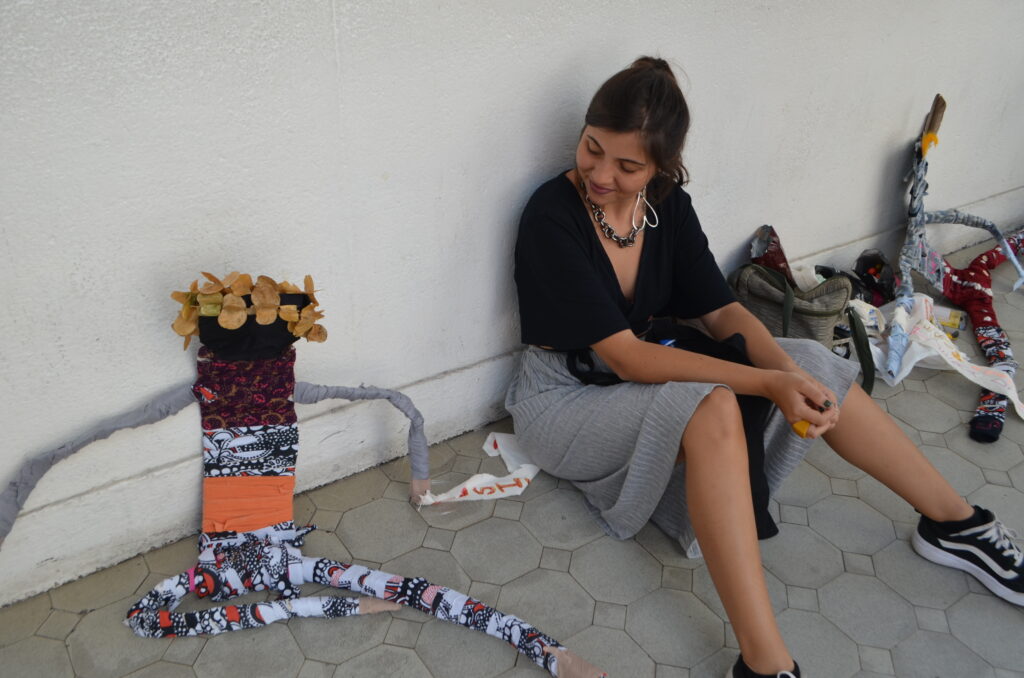
[1] The Zapatistas have gained a wide acknowledgement in academic circles for their resistance to capitalism. Anthropologist Arturo Escobar has even drawn the philosophical concept of pluriversal politics from the Zapatistas. Pluriversal politics advocates “a world where many worlds fit”. This marks a shift from the early 21st century slogan reclaimed in the World Social Forum “another world is possible”.
[2] See for example ”Fronteras y Cuerpos contra el Capital: insurgencias feministas y populares en Abya Yala” by Juliana Díaz Lozano, Delmy Tania Cruz Hernández, Lina Magalhães & Victoria Pasero, 2021.
[3] See the “Care Manifesto: the politics of Interdependence” by the Care Collective (2020) for more information about how governments can transform into a caring governments.
Text by Jasmin Immonen
